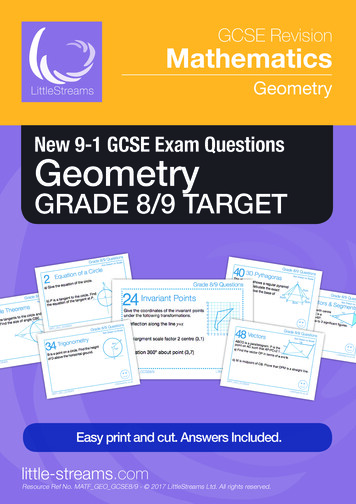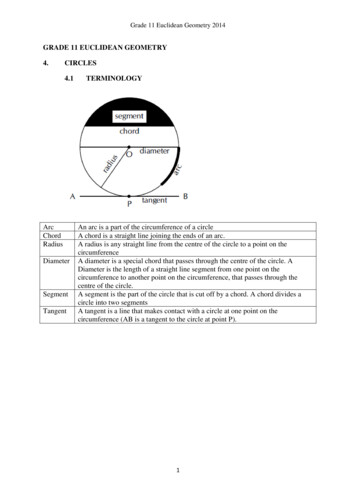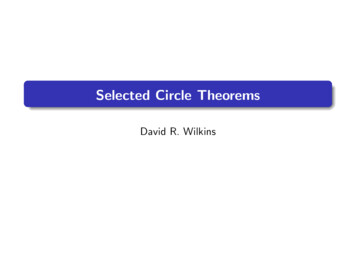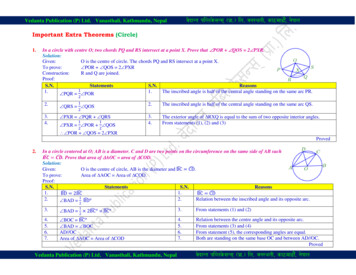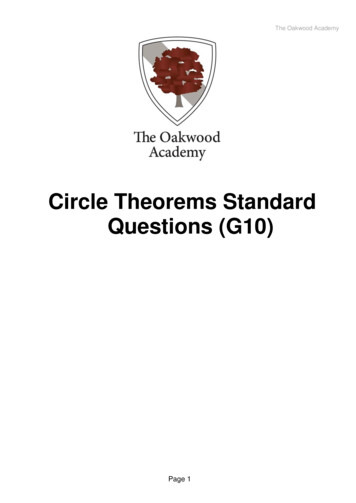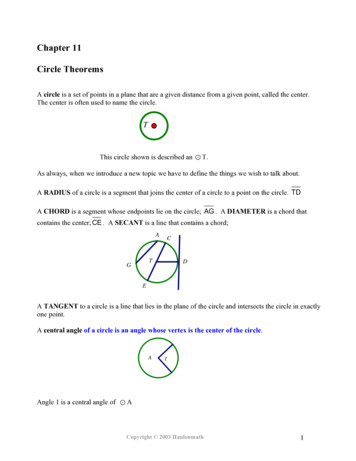
Transcription
Chapter 11Circle TheoremsA circle is a set of points in a plane that are a given distance from a given point, called the center.The center is often used to name the circle.TThis circle shown is described an T.As always, when we introduce a new topic we have to define the things we wish to talk about.A RADIUS of a circle is a segment that joins the center of a circle to a point on the circle. TDA CHORD is a segment whose endpoints lie on the circle; AG . A DIAMETER is a chord thatcontains the center; CE . A SECANT is a line that contains a chord;ACTGDEA TANGENT to a circle is a line that lies in the plane of the circle and intersects the circle in exactlyone point.A central angle of a circle is an angle whose vertex is the center of the circle.A1Angle 1 is a central angle of ACopyright 2003 Hanlonmath1
A minor arc of a circle is the union of two points on the circle and all the points of the circle that liein the interior of the central angle whose sides contain the two points.The measure of a minor arc is defined to be the measure of its central angle.What that means is that if the measure of the minor arc is 50º, then the measure of 1 is 50º.50 1A semicircle is the union of the endpoints of a diameter and all the points of the circle lying on oneside of the diameter.An inscribed angleis an angle whose vertex lies on the circle and whose sides contain chordsof a circle.2hºAngle 2 is an inscribed angle.Before we start, let’s look at two theorems.TheoremIn the same or congruent circles, if two central angles are congruent, their arcs arecongruent.TheoremIn the same or congruent circles, if two minor arcs are congruent, the centralangles are congruent.If I played long enough with arcs and chords, I would find that congruent arcs have congruent chordsand congruent chords have congruent arcs. Those would be easily proven using the congruencetheorems for triangles.Copyright 2003 Hanlonmath2
TheoremIn the same or congruent circles, congruent chords have congruent arcs.TheoremIn the same or congruent circles, congruent arcs have congruent chords.TheoremA diameter that is perpendicular to a chord bisects the chord and its two arcs.To prove this theorem, we draw the picture, draw lines so triangles are formed, prove the triangles arecongruent by HL Congruence Postulate, the rest falls into place nicely.Theorem:A diameter that is to a chord bisects the chord and its 2 arcsAGiven:Circle OAB XYProve:XK YK!!XB YB O1 2KXYBStatementsReasons1.Draw OX and OYConstruction2.AB XYGive3.OK OKReflexive4.OY OXRadii of circle are 5. OKX OKYHL6.XK YK 1 2cpctc!!XB YB2 central ’s are , the arcsare 7.The only information we have about the measure of angles formed with a circle is the definition of acentral angle. The measure of the central is defined to be the measure of the arc that it intercepts. SoCopyright 2003 Hanlonmath3
if we want to find the measure of other angles, it would seem we would have to somehow the angle,such as an inscribed angle, can be related to a central angle.These theorems and postulates will allow us to find more information about the measures of anglesand chords when dealing with circles. The next theorem is an example of how al this information fitstogether and results in more deductions.Arc Addition PostulateThe arc addition postulate is parallel to the segment additionpostulate and the angle addition postulate. That is, an arc is equalto the sum of its parts.ABarc AC arc AB arc BCCTheoremThe measure of an inscribed angle is equal to half the measure of the interceptedarc.A1B1 1 !AB2To show this relationship about inscribed angles, I’m going to draw one of the rays through thecenter of the circle as shown below.By drawing the ray through the center, I can then construct a triangle where one of the angles isa central angle – as shown below. AOB is isosceles because two of the sides are radii, thatmeans that A B; base angles of an isosceles triangle are congruent.Copyright 2003 Hanlonmath4
AOC is a central angle, but it is also an exterior angle of a triangle, which means that it isequal to the sum of the two remote interior angles. With that background, let’s look at theproof of this theorem.TheoremThe measure of an inscribedintercepted arc. is half the measure of theB ABC inscribedGiven:Prove: ABC 1 !AC2 OACStatementsReasons1.Draw OAConstruction2.OB OARadii3. A B2 sides of are , ’sopposite are 4. AOC A BExt 2 remote int ’s5. AOC B BSub6. AOC 2 BD-Prop7.1 AOC B2DPE8. AOC !ACCentral , arc9.1!AC B2SubThat proof was a special case because I drew my ray through the center of the circle. What would havehappened if I did not?BOCAXCopyright 2003 Hanlonmath5
Again, always go back to what you know. I could construct a ray from B going through the center ofthe circle – Ray BO.Now I can use the information I have just proven, plus I know the Angle Addition Postulate;that ABC ABX XBC.That information will allow us to find the measure of an arc formed by an inscribed angle or themeasure of an inscribed angle as shown below.XSF40 VTH170 X 85 Arc SH 80 CorollaryIf two inscribed angles intercept congruent arcs, the angles are congruent.A 1 and 2 both interceptarc AB, 1 221BCorollaryIf a quadrilateral is inscribed in a circle, the opposite angles are supplementary.CorollaryAn angle inscribed in a semicircle is a right angle.The intercepted arc of asemicircle is 180 Copyright 2003 Hanlonmath6
TheoremWhen a secant ray and a tangent ray are drawn from a point on a circle, themeasure of the angle formed is equal to half the measure of the intercepted arc.h 312 3 h TheoremWhen two secants intersect in the interior of a circle, the measure of the angle isequal to half the sum of the measures of the arcs intercepted by that angle and itsvertical angle.h 4k 4 1 (h k)2To prove this theorem, I will continue to use the strategies I have used before. First, I willdraw the picture with the information given to me. Second, I will add lines so I can relate thisto problems I have solved before, and third I will label the diagram.In this proof, I will be able to construct a triangle by connecting two points, that triangle willhave an exterior angle formed (the angle I want to find), and there will be two inscribed anglesformed. The relationship between the exterior angles and the two remote interior angles is thebasis for our proof.Let’s start, first the picture and the line that connects the points X and W. Label the angles.Copyright 2003 Hanlonmath7
TheoremWhen 2 secants intersect in a circle, the formed is tothe arcs formed by the vertical .Given: XY & ZW intersect1the sum of2YZ131Prove: 1 ( !XZ !YW )22WXStatementsReasons1.Draw XWConstruction2. 1 2 3Ext of sum of 2 remote int ’s3. 2 1!ZX21 ! 3 YW2Inscribed 4. 1 1 ! 1!ZX YW225. 1 1 ! !( ZX YW )21intercepted arc2Substitution in step 2Distributive PropNotice the importance of the triangle theorems in these proofs.To find the measure of 1, take half the sum of the intercepted arcs 1 ½ (120 40) 1 ½ (160) 1 80 40 120 1Copyright 2003 Hanlonmath8
TheoremWhen two secant rays, a secant ray and a tangent ray, or two tangent rays aredrawn to a circle from an exterior point, the measure of the angle formed is equalto half the difference of the measures of the intercepted arcs.k h 5 5 1 (k – h)2To prove that theorem, I would draw the picture, draw a line and start labeling. Let’s look. Notice bydrawing BC, I have formed two inscribed angles, 1 and 2 and a triangle. 2 1 5 5 2 – 1 1 ½ h and 2 ½ kExt angle of s sum of 2 remote interior anglesSubtraction Property of EqualityInscribed anglesFinding 5 is just a matter of substituting those values for angles 1 and 2 into the equation.AC25hk1PDB90 T T ½ (90 – 40 )40 T 25 Copyright 2003 Hanlonmath9
TheoremA tangent to a circle is perpendicular to the radius drawn to the point of tangency.(The converse of that theorem is true also.)TheoremIn the same or congruent circles, if two chords are congruent, they are equallydistant from the center. (Converse is true)To prove that theorem, again you would draw the picture, try to make triangles, prove the triangles arecongruent or similar, then use cpctc or a proportion.TheoremWhen two chords intersect within a circle, the product of the lengths of thesegments of one chord is equal to the product of the lengths of the other chord.acdbab cdLet’s look at the proofXGiven: Chords XY & ZWWdaK Prove: a b c dbZcStatementsYReasons1.Draw XZ and WYConstruction2. X W Z YInscribed ’s interceptsame arc3. XKZ and YKW are Vert Def. Vertical 4. XKZ WKYAA Postulate5.a c d b ’s proportion6.ab cdProp of ProportionCopyright 2003 Hanlonmath10
Using the previous theorem, find the value of x.1266(6) 12xx6Using the previous theorem, we know the products of the segments are equal. That means that12 x 6 6 or 12x 36.x 3TheoremIf two secants are drawn to a circle from an exterior point, the product of thelengths of one secant and its external segment is equal to the product of the othersecant and its external segment.rxysrx syCopyright 2003 Hanlonmath11
TheoremIf 2 secants are drawn to a circle from an exterior pt, the product of thelengths of one secant segment and its external segment is equal to theproduct of the other secant and its external segment.Given:secants PX and PYProve:PX PY PZ PWXYPWZStatementsReasons1.Draw XW and ZYConstruction2. X ZInscribed , same arcs3. P PReflexive4. XPW ZPYAA Postulate5.PX PW PZ PY ’s, sides in proportion6.PX PY PZ PWProp of ProportionTheoremIf a tangent and a secant are drawn to a circle from an exterior point, the squareof the length of the tangent segment is equal to the product of the lengths of thesecant segment and its external segmentmutt² m uCopyright 2003 Hanlonmath12
Circle Theorems A circle is a set of points in a plane that are a given distance from a given point, called the center. . In this proof, I will be able to construct a triangle by connecting two points, that triangle will have an exterior angle formed (the angle I want to find), and there will be two inscribed angles .
